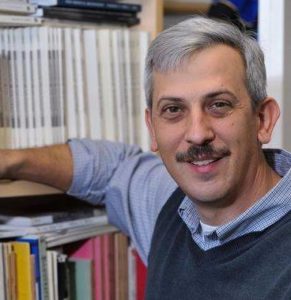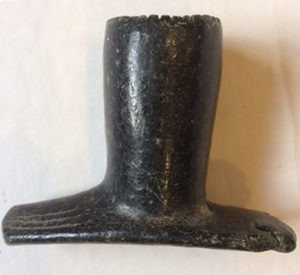The Deats/Thatcher Collection: An Interview with Dr. Richard Veit

Richard Veit is Professor of Anthropology and Chair of the Department of History and Anthropology at Monmouth University.
Professor Veit received his BA, summa cum laude, from Drew University (1990), his MA in Historical Archaeology from the College of William and Mary (1991), and his Ph.D. in Anthropology with a focus on historical archaeology from the University of Pennsylvania (1997). His research focuses on historical archaeology in the Middle Atlantic region from the late 17th through 19th centuries.
Professor Veit is the author or co-author of numerous peer-reviewed articles and reviews and six scholarly books. Two of his books, Digging New Jersey’s Past and New Jersey: A History of the Garden State are listed on the New Jersey State library’s 101 Great New Jersey books list.
Currently, Dr. Veit serves on the New Jersey Historical Commission and on the boards of the Archaeological Society of New Jersey and the Museum of Early Trades and Crafts. He is a Past President of the Middle Atlantic Archaeological Conference. He also served on the boards of the Society for Historical Archaeology and the Council for Northeast Historical Archaeology. His research has been featured in PBS documentaries, on NPR’s academic minute, and in Archaeology Magazine and he has been a TED speaker.
HCHS was lucky to have Dr. Veit review the Deats/Thatcher Archeological Collection and was instrumental in identifying museum quality pieces of the collection. We were able to interview Dr. Veit recently about the collection.
When I first saw the collection I was blown away by it and the richness and the quality of the items of the collection.
Q: How did you get involved with reviewing the Deats/Thatcher Collection?
A: I am an archaeologist who studies New Jersey’s past. I was familiar with Hiram Deats because I had read some of his publications on local history. I learned that his Native American artifact collection survived and was quite extensive. Working with the Hunterdon County Historical Society, I taught a summer class that looked at some of the artifacts in the collection. When I first saw the collection I was blown away by it and the richness and the quality of the items of the collection. Some of the items are truly museum quality artifacts. One can spend a whole career excavating and not see artifacts like that. I was thrilled to be asked to help assess the collection. It is one of the richest and most interesting Native American artifact collections in the state and illustrates important aspects of Hunterdon County’s Native American heritage.
Q: How was Mr. Deats able to collect these artifacts?
A: Mr. Deats came into a substantial fortune through his family and it was a trend of the times for the wealthy to collect. Mr. Deats was a collector’s collector. He was into stamps, coins, historic documents and, thank goodness, he became interested in Native American artifacts. He falls into a broader cultural milleu. I see him as a really inquisitive collector genuinely interested in history and he had a profound love for Hunterdon County, New Jersey and Fleminton. Anything that spoke to the history of that area he felt was really important.
Q: How did Mr. Deats find the artifacts?
A: He was trading with other collectors and buying collections when they were available for sale. I don’t know if he did any formal excavations, but there’s a cache of several stone tools and blades that may have come from a hole dug for a fence post on his property.
Imagine all the different cultures and events and the amount of time this pipe survived.
Q: Which pieces are most interesting to you and why?

A: There are a number of interesting pieces in the collection, including some incredible Native American tobacco pipes, beautifully made projectile points, and important ethnographic pieces. My favorite piece is Chief Tuccamirgan’s pipe. This pipe, apparently gifted to the Case family, is a smoking pipe made from stone. It has a form that is known as a monitor pipe—it resembles the Civil War battleship. It probably predates Tuccamirgan’s life as this style tobacco pipe was popular roughly 1,000 years ago. Tuccamirgan was associated with the pipe 250 years ago and it was gifted to some of the first Europeans that came to America. Imagine all the different cultures and events and the amount of time it’s survived. I find it fascinating for what it tells about interactions between Native Americans and settlers and also ideas of oldest piece in the collectionmemory and remembrance.
Q: What is the oldest piece?
A: That is a tough question. Some of the artifacts date back to at least 8,000-10,000 years ago, a period archaeologists call the Early Archaic, when Native Americans were supporting themselves by foraging, hunting, and fishing. The way we figure age is by comparing the collection finds with pieces that have been excavated with very strong dates based on natural layers of soil or scientific dating techniques.
Q: What is the importance of this collection to the general public?
A: The collection is important as a record of the earliest history of Hunterdon County, before European settlers arrived. I see it as one of the treasures of one of New Jersey’s finest historical organizations, the Hunterdon County Historical Society. It also tells us something about how scholars built collections of artifacts in the 19th and 20th centuries.
Q: How can people view the collection?
A: The highlights of the collection can be seen online, the entire collection survives at the Hunterdon County Historical Society’s Archives and the Flemington Public Library.
Support for this program is provided in part by a grant from the Astle-Alpaugh Family Foundation. A special thanks to Mr. Bob Sands, Project Manager and consultants Dr. Richard Veit and Dr. Gregory Herman.
